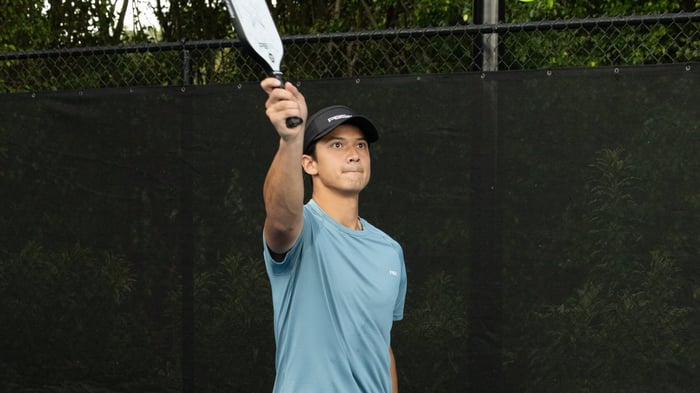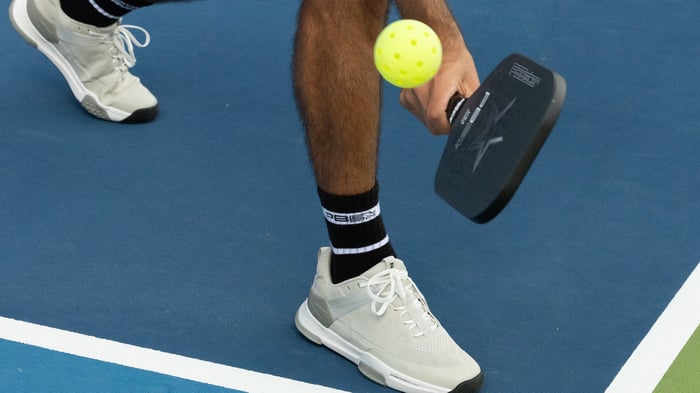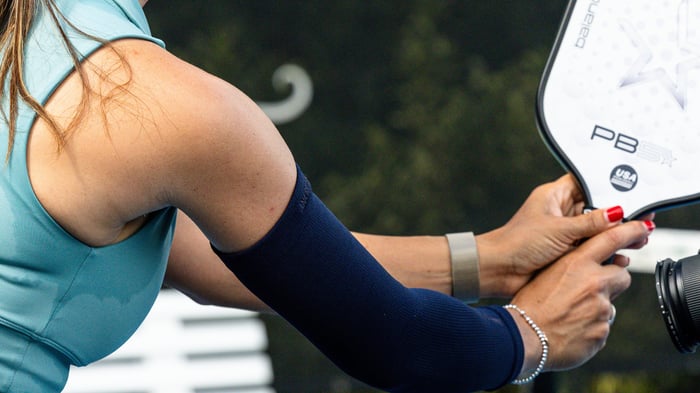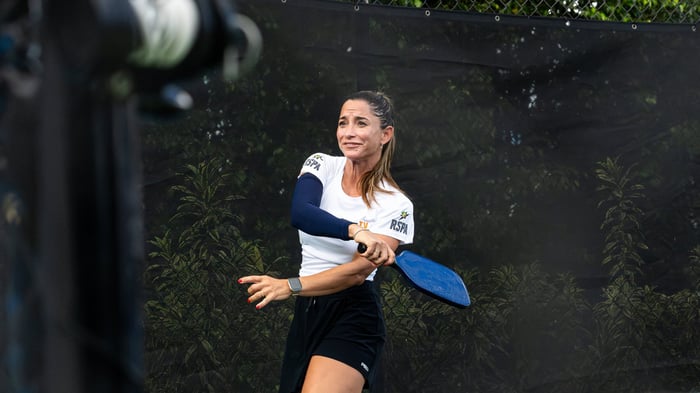Key takeaways:
The fake dink shot is a powerful, deceptive technique that transforms a soft, defensive-looking shot into an unexpected offensive play.
Mastering the fake dink shot requires a combination of precise technique, convincing body language, and strategic timing to maximize its effectiveness during high-pressure moments.
Using performance-ready gear that supports quick movements and confidence on the court can enhance your ability to execute advanced shots like the fake dink precisely.
In competitive pickleball, the difference between winning and losing often comes down to split-second decisions and strategic deception. While most players focus on power and placement, the most innovative competitors understand that deception and aggression can turn the tide of any match. This move transforms what appears to be a gentle, unassuming shot into a surprise attack that catches even experienced opponents off guard.
But here's what most players miss: understanding the fake dink shot and how to do it goes beyond simple mechanics. This shot allows you to control the pace while keeping your opponents guessing. You'll dictate the flow of each rally and add layers of complexity that separate good players from great ones. At PB5star, our performance-ready apparel is designed to support the quick movements and strategic plays that make advanced shots like this possible.
Understanding the fake dink shot
The fake dink shot is a clever maneuver in pickleball, transforming a gentle shot into an offensive weapon. It mimics standard dinks but surprises opponents with a sudden change in pace or direction. This technique turns unattackable balls into scoring opportunities, catching even seasoned players off guard during kitchen exchanges. Its strength lies in disrupting opponents' rhythms during intense rallies, forcing them into reactive states that often lead to missed volleys or panicked responses.
For competitive players, the fake dink shot can shift momentum in tight matches. Imagine a crucial game at 9-9, where you establish a rhythm with genuine dinks before executing a deceptive shot toward your opponent's backhand corner. This unexpected acceleration can lead to errors, giving you the point. Understanding your opponent's reactions is key, as skilled players may respond quickly, creating rapid exchanges that demand sharp reflexes and positioning.
How to execute the fake dink shot
Learning how to fake a dink shot requires mastering both the physical technique and the mental game of deception. The key lies in selling the illusion completely before switching to your attack mode.
Establish proper court positioning: Stand with feet shoulder-width apart, knees bent, and paddle angled slightly downward at waist height to create the foundation for soft shots and surprise attacks.
Commit fully to the deceptive motion: Begin your swing path with complete conviction, maintaining relaxed body language and smooth paddle movement to convince your opponent you're delivering another routine dink.
Execute the last-second transformation: Just before contact, add a slight flick of your wrist and adjust your grip pressure to create sudden acceleration, transforming the expected soft shot into a controlled attack.
Practice alternating drill sequences: Work with a partner to alternate between real dinks and fakes during rallies, building your ability to disguise intentions while developing timing recognition of opponent reactions.
Master shadow practice sessions: Rehearse the fake motion without hitting balls to perfect your body mechanics and ensure your deception looks authentic from start to finish.
Deploy strategic timing: Use the fake dink when opponents expect soft returns during extended rallies, catching them off-guard when they're positioned for defensive play rather than aggressive responses.
Through consistent practice and intentional drills, you’ll develop the timing, body control, and mental sharpness needed to make this shot seamless and unpredictable. When executed with precision and strategy, the fake dink becomes a powerful disruptor, turning defensive moments into offensive opportunities and keeping your opponents on their heels throughout the match.
When to use the fake dink shot for maximum impact
In high-stakes pickleball matches, every shot counts, but it’s not always power that wins the point. The fake dink shot is a crafty, game-changing tactic designed to catch opponents off guard and shift momentum in your favor. Below are the key moments when this deceptive shot can have maximum impact.
Break the stalemate: Use the fake dink during tense moments when the match hangs in the balance. It’s a momentum-shifter that disrupts your opponent’s expectations.
Exploit pressure points: High-stakes situations demand deception; this shot shines when your opponent is locked into predictable patterns under pressure.
Punish net rushers: Opponents who charge the kitchen line are ideal targets; catch them overcommitted and force awkward or panicked responses.
Surprise soft return anticipators: Deploy the fake dink when rivals lean in expecting a gentle dink; the sudden switch throws off timing and leads to missed volleys or pop-ups.
Capitalize on commitment: Wait for opponents to show their hand. If they’re committing to a read, that’s your cue to flip the script with a disguised shot.
Mastering the fake dink isn’t just about execution; it’s about timing, awareness, and reading the game. Using it strategically, especially under pressure, can unravel even the most seasoned opponents. Add it to your arsenal as a disruptive weapon to break through deadlocks and take control of crucial points.
Common mistakes and how to avoid them
Even experienced players fall into predictable patterns when learning the fake dink shot. Recognizing these common mistakes with the fake dink shot will help you refine your technique and maintain the element of surprise that makes this shot so effective.
Avoid overusing the fake dink in a single match: Deploy it sparingly rather than making it your go-to move, making it predictable and losing its strategic value.
Keep your backswing compact: Taking too large a backswing shows your intentions and reduces control, while a subtle paddle movement maintains the deception that makes the shot work.
Maintain consistent body language: Early grip changes or apparent weight shifts give away your plan before you execute, so practice keeping the same stance and paddle position as a regular dink until the last moment.
Reset your position immediately after the shot: Failing to recover quickly leaves you vulnerable to counterattacks, especially against skilled opponents who can turn your aggressive move against you.
Read your opponent's skill level accurately: Against advanced players, be prepared for quick reactions and have a defensive plan ready, as underestimating their ability to counter can backfire and put you on the defensive.
The fake dink shot is only as effective as the discipline and subtlety behind it. By avoiding these common pitfalls, you preserve the element of surprise and keep your opponents guessing. Practice with intention, and the fake dink will become one of your most reliable momentum-shifting moves.
Frequently asked questions (FAQs) about the fake dink shot
Competitive players often have specific questions about perfecting advanced techniques like the fake dink shot. These frequently asked questions address the most common concerns about execution, practice methods, and the gear that can support your strategic gameplay.
What are the best tips for mastering the fake dink shot?
The foundation of an effective fake dink lies in your body language and timing - you must convincingly mimic a standard dink setup before making your move. Focus on maintaining the same paddle position and stance you'd use for a regular dink, then make a quick adjustment at the last moment to catch your opponent off guard.
How can you practice the fake dink shot effectively with a partner or in drills?
Building on proper technique, structured practice transforms theory into match-winning execution. Start with controlled partner rallies where you alternate between real and fake dinks, focusing on selling the deception through consistent body mechanics. Set up specific scenarios where your partner feeds you balls at the kitchen line, allowing you to practice recognizing the right moments to deploy your fake.
What gear or apparel features can help you execute deceptive shots more confidently?
Regarding gear that supports advanced shot-making, mobility, and comfort are your primary concerns. Performance-ready apparel with strategic stretch zones and enhanced flexibility around the shoulders, arms, and torso allows quick, unrestricted movements to transition from fake setups to aggressive shots.
How do you recover quickly after attempting a fake dink shot?
Recovery positioning becomes even more important after executing deceptive shots, often creating unpredictable rally dynamics. Immediately after your fake dink, reset to your ready position with your paddle up and weight balanced on the balls of your feet, prepared for a potentially fast return.
Play better, look better, and outsmart the competition
Mastering deceptive shots like the fake dink requires more than technique; it demands confidence, comfort, and the ability to stay composed under pressure. Success on the court comes from repetition, strategy, and the right mindset. But just as crucial is having gear that supports your movement, enhances focus, and lets you play without distraction.
At PB5star, we understand that performance and presentation go hand in hand. That’s why our performance-driven apparel is explicitly designed for competitive players who refuse to compromise on style, function, or mindset.







